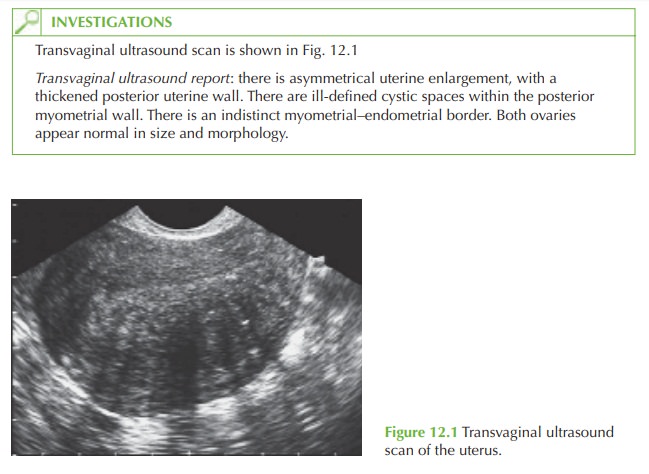Chapter: Case Study in Obstetrics and Gynaecology: General Gynaecology
Case Study Reports: Painful Periods
PAINFUL PERIODS
History
A
43-year-old woman is referred from
her general practitioner (GP) with painful
periods. She says that her periods
have always been quite heavy
and painful but that in the last 2–3
years they have
become almost unbearable. She bleeds every
24 days and
the period lasts for 7–9 days with very heavy flow from day 2 to day 6. The pain starts approximately 36 h before the onset of the bleeding
and lasts until
about day 5. The pain is constant, dull and severe, such that she cannot do any housework
or any social activities during this
time. Her GP has prescribed paracetamol and mefenamic acid in combination, which she says ‘takes
the edge off’ but does not fully relieve
the symptoms.
She
has had four normal deliveries and her husband
had a vasectomy several years
ago.
There is no history
of intermenstrual or postcoital discharge and she has
no abnormal dis- charge. Her smear history
is normal, the most recent
being 18 months
ago. She takes citalopram for depression but
currently reports her
mood as fine.
She does not
drink alco- hol or smoke.
Examination
The
abdomen is soft and there is vague tenderness in the suprapubic area. The cervix appears normal. On bimanual
palpation the uterus
is approximately 10 weeks
size, soft and bulky.
She is tender
on palpation but
there is no cervical excitation, adnexal tender-
ness or adnexal masses.

Questions
·
What is the likely diagnosis?
·
How
would you further
investigate and manage this woman?
Answer:
The symptoms of dysmenorrhoea and menorrhagia and the ultrasound report suggest a diag-
nosis of adenomyosis. This is a benign
condition whereby functioning endometrial glands
and stroma are found within
the myometrium. With each period
bleeding occurs from the
endometrial tissue into the smooth muscle, with associated pain. It tends to
occur in women over 35 years and
risk factors include
increased parity, termination and previous
Caesarean section. The condition may commonly be found in association with
endometriosis. Classically the diagnosis may only be made histologically after hysterec- tomy for
dysmenorrhoea. More recently however the diagnosis can be suspected by ultra- sound or magnetic resonance imaging (MRI) scan.

Further investigation
If
the diagnosis is in doubt then an MRI scan may be requested. Hysterectomy to obtain histological
diagnosis would be inappropriate.
Management
The initial management involves
analgesia such as mefenamic acid and codydramol. Tranexamic acid reduces the amount of bleeding and this may secondarily reduce the
amount of pain. Suppression of menstruation with gonadotrophin-releasing hormone analogues is a short-term measure. The levonorgestrel-releasing intrauterine device is another option
to locally suppress the endometrial tissue,
and may resolve
the pain.
As a last resort hysterectomy should
be performed.

Related Topics